Writing
What Books Should Every Sculptor Have On Their Book Shelf?
Want to know what books every sculptor should have on their shelf? Here is a recent article that I wrote for Best of Artists and Artisans titled “From the Book Shelf of Sculptor Bridgette Mongeon”
Sometimes Interviews Can Be Very Personal
That is the case with this article, probably the most personal interview I have ever given. But I must say the writer did a great job. Check out Beauty for Ashes: The Inspired Art of Bridgette Mongeon.
An Interview With Sculptor Camille Allen

I interviewed Camille Allen for my February Column on Best of Artists and Artisans. Her work is amazing and something to really check out.
Sculpture- A Reflection of Faith
Created for Best of Artists and Artisans Website
By Bridgette Mongeon © 2009
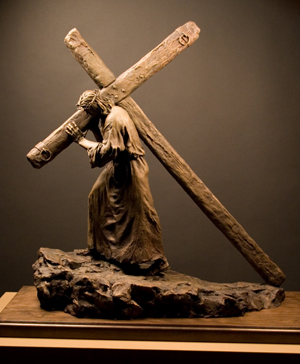
We are in the middle of what some would call a holy season of Lent, leading up to Passover, and then Easter Sunday. This solemn time of reflection in faith caused me to seek sculpture that does the same. In this month’s article we will showcase the work of traditional “liturgical art,” as well as not so traditional art based on the faith or with a message of faith. When reviewing different artists it is important for me to hear the description of the art. A titled work and descriptions add life to the piece, gives it meaning and creates a rapport between viewer, art, and artist. Equally, there is an urgency in my discovery of the process of each individual artist. I want to know more about their own faith. What drives them to spend so many hours creating these images? Is it of necessity that they driven to create? Do they feel a message must be conveyed? Is there a spiritual dance between them and the Great Creator as they mingle passion, art and faith? Here are the answers of five passionate and spiritual artists.
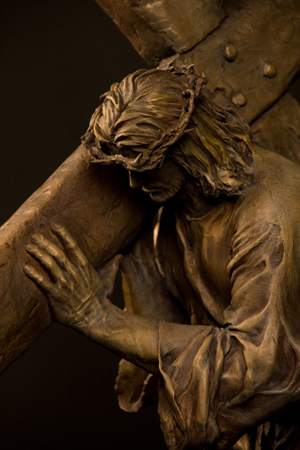
ArtistAngela Johnson
www.ajsculptures.com
Art quietly speaks volumes. At this Easter time it gives me joy to share my pieces, Because of Love and Lazarus, Come Forth. The most fascinating aspect of art for me is what can be communicated from the artist to the viewer. Every artistic decision of compositional design is determined with the desire to share a perspective,
belief or quality about the subject being created. In the sculpture, Because of Love, it was my desire to portray the incomprehensible act of love of Jesus Christ is suffering the weight of the sins of the world. The majesty and power of His love is portrayed and embedded in this work. The strain of His muscles, His bearing being strong, yet submissive to the will of His Father are meant to draw the viewer into contemplation of His Great, Infinite sacrifice of Love.
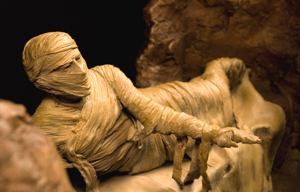
Lazarus, Come Forth sculpturally depicts the miracle of Jesus raising Lazarus from the dead. The biblical account states that Lazarus had been in the grave four days. Beyond all the miracles Jesus Christ had already performed was this yet greater impossibility of raising someone from the dead long after their spirit had left the realm of earth. I think a great deal about the reaction of Mary and Martha as they struggle in amazement and disbelief as they see their brother who was one dead, alive again. When we pray and ask God to grant a blessing or we personally witness a miracle what is our reaction? How grateful and changed are we as we experience the power of God? Do we give God the glory or dismiss it as an unexplainable coincidence?
Artist
William Leslie
www.PaperSunLightsculpture.com
At the heart of existence there shines a light; Ner Tamid, the flame of the Divine’s ever radiant Presence. This light, which emanates from the inside out, expresses the timeless ideals towards which all individuals and nations strive; Wisdom, Love, and Justice.
Wisdom is the knowledge of the true nature of the human condition and the Sacred Mystery; Love is found in the deep concern for the well being of all living things, especially the least advantaged and most vulnerable; and Justice is the manifestation of Wisdom and Love in action, the right ordering of society such that the dignity of all is cherished and protected.
These three virtues are expressed in the three upward aspiring fingers of the flame in this representation of Ner Tamid. Their unity and interdependence is signified by the manner in which the three fingers twist around each other after emerging from a common base.
It is the wish of the artist that this expression of the Eternal Flame inspire every individual and all nations to be exemplary lights to guide humanity through the dark night of these bewildering times, and to remind us of the undying presence of the Divine.

The aesthetic appeal of my lightsculptures is evocative of what we find beautiful in natural forms; the swirl of texture in marble or wood grain, the evolving folds in flowers or lichen, the patterns left in windswept or sea swept sand. Everywhere we look we see that nature prefers to move in graceful trails, or to organize itself in beautiful patterns.
I began thirty years ago calling my work “lanterns” or “artistic light fixtures.” Gradually my work has evolved to become more sculptural, less functional. While my clients (ranging from homes to businesses, hospitals to restaurants) are often seeking a source of illumination for an occupied space, they also desire something that stands alone as a work of art whether the light is on or off. It is this wish to grow beyond the functional, to create truly beautiful illuminated sculptural forms that motivates my efforts now.
Ner Tamid resides in Unitarian Universalist Fellowship in Vista, CA.
ArtistNancy Winship Milliken
www.nancymilliken.com
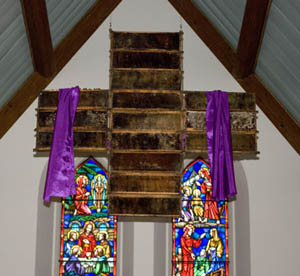
Out of Many, One, dimensions variable upon installation (cross is 51”x51”x2”), wood, beeswax, honey, muslin, steel, 2008.
The piece is constructed out of honey frames from a bee hive. It has the balance of the Red Cross symbol as it hangs suspended from the ceiling. There is a waxed muslin catch-pan filled with honey underneath and waxed muslin is draped over the extended arms of the cross. There is a lovely sweet smell of wax and honey and a depth of natural color of the old honeycomb.
Out of Many, One, II, dimensions variable upon installation (cross is 51”x51”x2”), wood, beeswax, steel, polyester, 2009. The piece is similar to the above Out of Many, One description except without the catch-pan of honey and the material draped is interchangeable, purple for lent, red and black as needed. This cross now installed at Calvary Church in Stonington, Connecticut, will come down for Easter and be replaced with a cross that I have made out of the same frame construction, filled with white flowers.
The Lamb, installation size variable,( 7’, 10’, or 15’) wool, felt, polyester, 2009. The wool has been kept in the raw, so the smell of lanolin and animal is vaguely familiar, ancient, visceral. The wool is needle felted into a felt substrate, using an old technique employed by homesteaders all over the world. The subtle colors and design of the wool, the texture and smell present in contrast to the purple polyester shine adds intrigue and contemplation.
Artist Statement
Art for me is where science and the spiritual connect. For these above mentioned pieces the concepts of sacrifice and service were always front and center. Out of Many, One, is titled for both the collaborative work ethic and social constructs of the honeybee colony and our national motto, E Pluribus Unum, found on the seal of the United States and on our dollar bill. The bees work for the benefit the whole colony, even giving their lives in defense of their productive hive. With the recent colony collapse disorder that the nation’s bees have been experiencing, I believe the materials that I have chosen to be symbolic of not only humanitarian behaviors, but also reflective of our environmental impact on the honeybee.
In choosing the symbol of the cross, and in particular the Red Cross, I am referencing the humanitarian gesture of service to others with disregard to country borders, skin color, sexual orientation, wealth or religion. Anyone who has experienced a natural disaster, a manmade calamity, or even succumbed to the power of water while swimming knows the calming effect of the Red Cross symbol flying on a flag meaning help is near. It is powerful and instills the feeling of hope as well as symbolizing sacrifice and service. The lamb has historically been a symbol of sacrifice. The method of attaching the fiber by pushing the wool into the felt with a long needle is laborious and a nod to the essential work of the homesteader. The contrasting shiny purple material representative of the color for Lent and the practice of doing without highlights the natural and authentic smell and texture of the wool.
As a last note about these pieces: They personally symbolize the faith I have in my art. I made a change in my career two years ago and I need to have faith in the unknown, the unseen, the future. By using untraditional materials unconventionally in my art, I am entering un-chartered territory. These traditional symbols are a reminder, a flag, of faith in my art.
Artist
Robert Winkler
www.robertwinklerscupture.com
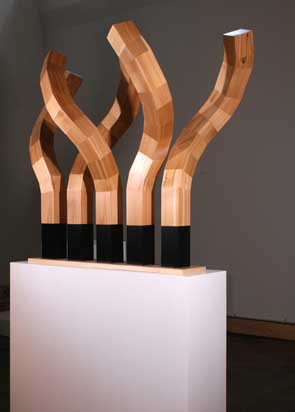
People often ask Robert Winkler what inspired one or another of his sculptures.
But, the more relevant question for Winkler is “what do his abstract forms inspire in the viewer?”—particularly in the case of Look Homeward, Angles. Like all of his works, it is deeply spiritual, humble in its simplicity and lack of ornamentation —with a minimal flow that allows the imagination to soar unimpeded.
In Look Homeward, Angles, his graceful-gravity challenging forms seem to resist the downward pull of the Earth and reach heavenward.
In a recent series of interior sculptures, Grow Up, the prayerful attitudes and upward reach of the twisted forms are both a paean to ephemeral beauty and a moving metaphor for the human struggle to transcend.
Since the early ‘90’s, Robert Winkler has been manipulating volume, mass and balance to create a sense of movement. His interior works make use of surprising combinations of materials, such as aluminum, steel, hand-laid papers, vellum, tempered masonite, and cedar. His large-scale outdoor works are primarily constructed of cedar, an organic material whose surface changes over time. Above all, it is his ability to find infinite variation within a limited number of shapes that sets him apart. Without so much as a single curved cut of wood, he achieves serpentine, animated forms through the use of incremental gradations. It is a discipline that offers no hiding place for error, demanding meticulous workmanship.
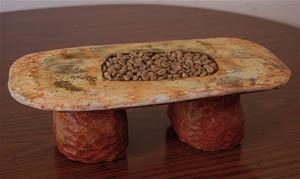
Artist
Sean Matthews
www.flickr.com/photos/seansaltars
My first experience with sculpture dates back to childhood. As a boy, Sunday Mass was the least exciting hour of the week and I often found myself daydreaming. I can think back to a reoccurring daydream of the Church spontaneously bursting into flames during a Sunday morning celebration. While the congregation was frantically storming the doors for safety, I was calmly carrying large marble sculptures of the Holy Family out from the fire. I remember thinking how I would be the hero who saved works of art from a burning church.
From time to time, I still find myself daydreaming during Mass. One Sunday, about six years ago, after my first semester of graduate school, I made a discovery that changed my process of object making. During Mass, while we were solemnly kneeling, I noticed a predominant object for what seemed to be the first time. I looked around the congregation and saw how all eyes were focused on the priest and the ritual he was performing around the altar. I remember looking at the altar as if it were a piece of minimal sculpture anchored in the center of a highly conceptual, performance piece. I was immediately inspired, and my mind began to race with ideas. This was a defining moment for me as an artist.
From the beginning of civilization, in every culture around the world, sacred articles, such as altars, shrines, and sanctuaries have been used to connect us spiritually to a place outside the physical world. I have found the altar to be a unique tool that can take almost any form so long as it has been consecrated to a significant purpose. The spiritual object symbolizes religious or secular memories and acts as a focal point where one prays, contemplates, or meditates.
I see the altar as a vehicle that drives a thought or a prayer into an intangible world. It makes an imperceptible connection between the participant and a memory. It is the tool that connects us to a thought, emotion, or a recollection, making visible that which is invisible. An altar can be specific to a location, or small enough to fit in one’s hand. It can be personal or for others, and is possibly the only devotional object that can connect all people, around the world, from the beginning of time through to the present.
My body of work revolves around the altar and its infinite forms. I explore the similarities between the altar and the object, and ask the viewer to determine the difference between the two. Form and craftsmanship is very important to my concepts because I believe that beauty in art is an extension of God. Mark Rothko writes, “The artist m
ust have sufficient means at his command to achieve his objective so that his work becomes convincingly communicative.”
My latest work is inspired by a Sicilian tradition called St. Joseph Altars. The focus of St Joseph Altars is baked goods and fruit. Breads are baked in symbolic forms such as carpenter tools and tools of the Passion; every food item on the altar has a special meaning. Because this tradition is practiced during Lent, meats are not included on the table. I have appropriated the idea of building an altar to a saint, but instead of paying homage to Saint Joseph, I am communicating my gratitude to Saint Luke, the patron of sculptors. In this body of work, small sculptures replace food. The materials I use are found objects and recycled wood and steel. My purpose for using these materials is to symbolize the Resurrection.
Altar XV
Plastic, cement and coffee beans,
Microlithic Altar
Wood and steal
A Bean Picker’s Altar
Wood, steel, coffee beans, coffee bean bag
All written work is copyrighted and cannot be used, whole or in part,
without the written consent of the author.
New Article- Milling- An Additional Tool of Advanced Technology For the Traditional Sculptor
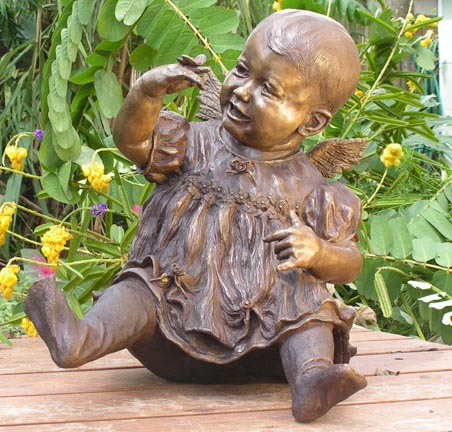
Created for Best of Artists and Artisans website
By Bridgette Mongeon © 2008
In this column’s May 2008 article, “Using the Computer and Poser in the Sculpture Studio,” I spoke about using the computer program Poser and Daz 3D to create my presentations for a sculpture called Jenna. I’d like to expand on that process to further assist the traditional artists utilizing technology in the studio. Some sculptors are utilizing digital scanning and milling to help enlarge their sculptures. I will expand on scanning in a later article, as there is quite a bit of information to relay about digital scanning. For this article we will focus on milling in foam.
If you remember with the sculpture of Jenna, both Poser and Daz 3D figures were combined to create several different visuals for the client to look at and approve. From there we took the computer generated 3D pose and sent it to Blue Genie Art Industries in Austin, Texas, for milling. First we made sure that the mesh, the underlying structure in a 3D computer model that gives it its shape and form, was watertight. This means that there are no holes in the mesh. Blue Genie Art Industries can examine files for an artist and provided this service as well.
Blue Genie Art Industries then took the Poser file provided and sent it to the (CNC) Computer Numerical Controlled milling machine. Here the CNC milling machine uses drill bits that move back and forth along the foam, carving out a foam replica of the 3d model that is in the computer.
Happy New Year
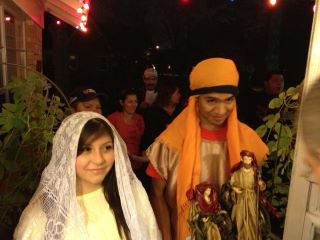
The studio has been quiet over the holidays as we spent time with family and friends. We had a Posada at the studio inviting friends and neighbors. A posada is a Mexican tradition of going to a different house each night for 7 nights. two people are dressed as Mary and Joseph and ask for lodging, which is done through singing. Several people stood outside the studio door and sang while others were inside signing back. In the end we all eat. It was a cold night.
The posada went well, and part of me wishes we would have also had an upside down Christmas Party as we have in the past. Maybe next year.
There are great adventures planned with the God’s Word Collectible series as well. And I am really looking forward to our Inspirations/Generations podcasts. A new one is up on New Years Resolutions. May you all have a wonderful and creative New Year.
Merry Christmas—And A Prayer For Those Who Are Ill

Recently I recorded a podcast about traditions. It was for Inspirations/Generations podast that I record with my mother, and daughter. It was about Christmas traditions. You can find the podcast on the God’s Word Collectible website, or if you like you can subscribe to it in ![]()
In it we talked about reading the Christmas story from the bible and reenacting the scene with the nativity figures. Well my children are grown and my daughter lives in another state, so instead I read in front of Jenna’s candle. Jenna’s candle was given to me by her mom and I was instructed to light it on special occasions.
Because a good deal of the year I am working on sculptures of loved ones who have died, I have a great compassion for my clients and others who have lost a loved one. This time of year is especially difficult. So I lit the candle for Jenna, and for all of those other children and I read the Christmas Story. I also prayed for those families who have family members who are struggling with cancer and illness. I thought about the children as I sat alone in my studio and read and prayed. May all families feel God’s comfort at this time.
Jenna’s candle is on a place that might be referred as my alter. It has special things that I like, a picture of my mom and myself, a stone elephant that I mention in my book “Bringing to Life the Spirit of the Deceased-A Sculptor’s Journey.” And a sculpture that someone created for me saying, “this sculpture represents your spirit. “
May all families feel God’s comfort at this time.
A Sculptor’s Bones–O.K.

I guess it is a little strange that I just finished a hand doctor’s portrait and I end up at a hand doctor. I should have made an appointment with Dr. Brown, but I didn’t want to to take a chance on blowing the surprise. The good news , there is no arthritis. I have some other problems that warrant resting hand in brace when not sculpting and using cream. Just thought the xray was so cool. A sculptor’s bones!
Signed The Contract Yesterday On A New Book
Digital Sculpting with Mudbox: Essential Tools and Techniques For Artists.
I am thrilled with the idea because I feel this book begins a cross over between digital sculpting and traditional sculpting. Something that has not been done before. I am working on the book with my husband Mike de la Flor. http://www.delaflor.com He brings the digital sculpting to the forefront, and I on the other hand, approach this from an entirely new and different perspective. I will be spending hours and hours, not just writing but also working in this program, and immersing myself into more and more technology. Things are changing out there and the technology that is coming up is a great resource for traditional sculptors.
Stay tuned for next years Houston Symposium on New Technology for Traditional and Digital Sculptors. It will be out after the book of course, and will include
* digital milling
* digital scanning ( including digital a new digital scanner that is affordable to the average studio, Too cool )
* digital printing
* digital printing in bronze and gold ( TOO COOL!)
* digital milling in wood
* digital milling in stone!
and who else knows what is going to come of this. IF it works well we hope to duplicate it in other cities, let us know if you would like to sponsor such an event, or if you have new technology that you might like to include.
Meanwhile it is back to the grindstone. Must put in estimates for projects and get back to the virtual sculpting stand.
In Loving Memory of Kittiana 1992-2008
Kittiana came into our lives at a time of fracture instability and uncertainty. She was from “Santa” and only because a friend, friend had kittens around Christmas time and I was just coming off a divorce and hard pressed to find Santa gifts. She arrived in the wee hours of my daughter’s 7th Christmas and took quickly to the animals that always sit around the base of the tree each Christmas. When I went to bed that evening she meowed so loudly was unsure of what to do. I found a stuffed cat and encourage her to lie next to it. It appeased her. In the morning we jumped up from bed and entered the living room. Christina bounding and I wondering where on earth this present was. Christina was distracted by some of the minor things under the tree until she noticed cat litter. At least Santa came prepared. The surprise on her face was priceless. I pretended to complain stating, “Santa better not have left a cat in this house.” T that moment the cat meowed from beneath the cabinet and Christina went quickly to retrieve her.
The bond was instant, and offered Chris a distraction from a dad who was not there. Kittiana took to sleeping on Christina’s head, and had a horrible playful, but painful habit of attaching her feat at night. Though Kittiana always looked small and kitty like, for many years visitors called her the unfriendly cat. She wanted no one except for Christiana.
Children grow, and you don’t realize that their pets are often left behind. Grade school came with slumber parties and slip and slides, junior high with guys and giggles, and high school with dreams and determination. When Christina went away to college Kittiana’s personality changed she mellowed. Perhaps we bonded because of our loss of the girl, the desperate need to feel that girlish love. Whatever it was, her allegiance switched. Soon Kittiana was banned from Chris bedroom. Whether it was because of her misunderstanding or her love of the girl, she would still try to “claim her territory,” even on visits and the summers when Christian came home.
Chris graduated college a year ago spring. She decided to continue to live in the Tulsa away from her Texas home. “I can barely be responsible for me, Please don’t make me responsible for my cat.” I understood the feelings. They were feelings I too had so many years ago alone with a mortgage, two dogs, a cat and a precious little girl.
My life has changed over the years. There is stability in a relationship, and a career. Kittiana and I developed a regular ritual. Evening snack, a glass of wine and sitting on the chair. She would snuggle, and do you know that the mean cat would let me hold her like a baby! I loved it and I think we both got what we needed. A year ago she was diagnosed with thyroid problems. Slowly her health declined and two weeks ago I made the decision and the appointment to put her down. I have had many pets, this one was hard to let go of, she represented so much more than a cat, and it was the last of my daughter’s childhood. Over the last two weeks I took numerous pictures, her 4 lb frame so frail. Christina has had ample time to work through her issues; it was mom that had to come to terms. Last night I snipped a bit of her hair, some black, some white and taped it together. I made two of these little locks. It is a tradition that I started from the first deceased pet. They all sit in a jewelry box in my dresser drawer, or course I’ll send one to Chris. The last week kittiana became fussy about food, and I felt it was something that she did to let me know, “hey it is really time.” She could afford to get no thinner. Today at 11:00 I held her as the doctor put her to sleep. Her ashes will arrive at another time. I feel good about my decision, and can easily go throughout the day without crying until I think of the two thoughts together, the girl and the kitty. Then I’m a mess. I’m very grateful we have had the bond. I guess it is o.k. to say, I miss them both and am grateful that all of our lives have touched.
My little boo boo kitty!

